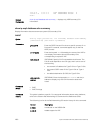
Usage
Information
You can configure an arbitrary value in the IP address format for each router.
However, each router ID must be unique. If you use this command on an OSPF
router process, which is already active (that is, has neighbors), a prompt reminding
you that changing the router-id brings down the existing OSPF adjacency. The new
router ID is effective at the next reload.
Example
Dell(conf)#router ospf 100
Dell(conf-router_ospf)#router-id 1.1.1.1
Changing router-id will bring down existing OSPF adjacency [y/
n]:
Dell(conf-router_ospf)#show config
!
router ospf 100
router-id 1.1.1.1
Dell(conf-router_ospf)#no router-id
Changing router-id will bring down existing OSPF adjacency [y/
n]:
Dell#
router ospf
To configure an OSPF instance, enter ROUTER OSPF mode.
S4820T
Syntax
router ospf process-id [vrf {vrf name}]
To clear an OSPF instance, use the no router ospf process-id command.
Parameters
process-id Enter a number for the OSPF instance. The range is from 1 to
65535.
vrf name (Optional) Enter the VRF process identifier to tie the OSPF
instance to the VRF. All network commands under this OSPF
instance are then tied to the VRF instance.
Defaults Not configured.
Command
Modes
CONFIGURATION
Command
History
This guide is platform-specific. For command information about other platforms,
refer to the relevant Dell Networking OS Command Line Reference Guide.
The following is a list of the Dell Networking OS version history for this command.
Version Description
9.7(0.0) Introduced on the S6000-ON.
9.0.2.0 Introduced on the S6000.
9.1(0.0) Added support for OSPFv3 on the S4810 and Z9000.
Open Shortest Path First (OSPFv2 and OSPFv3)
1303


















